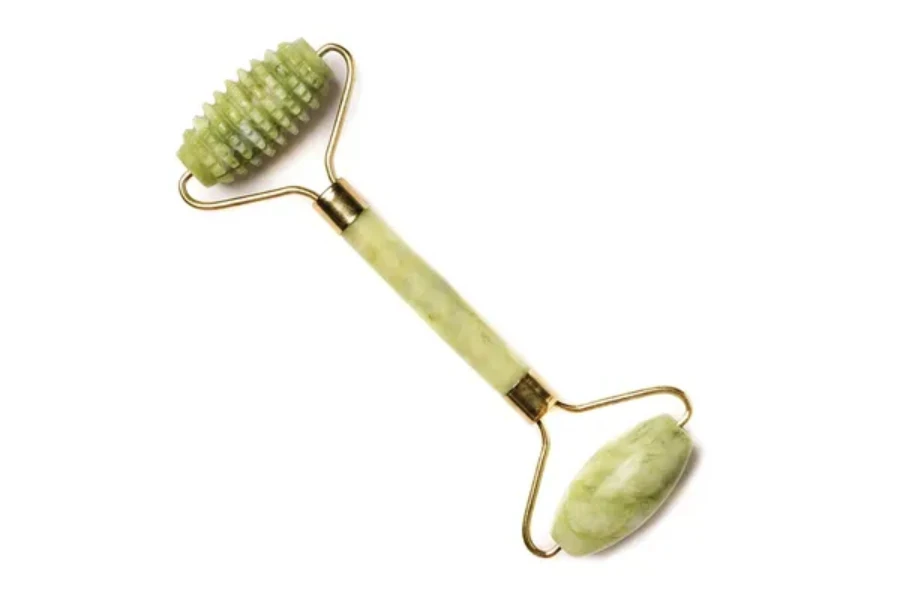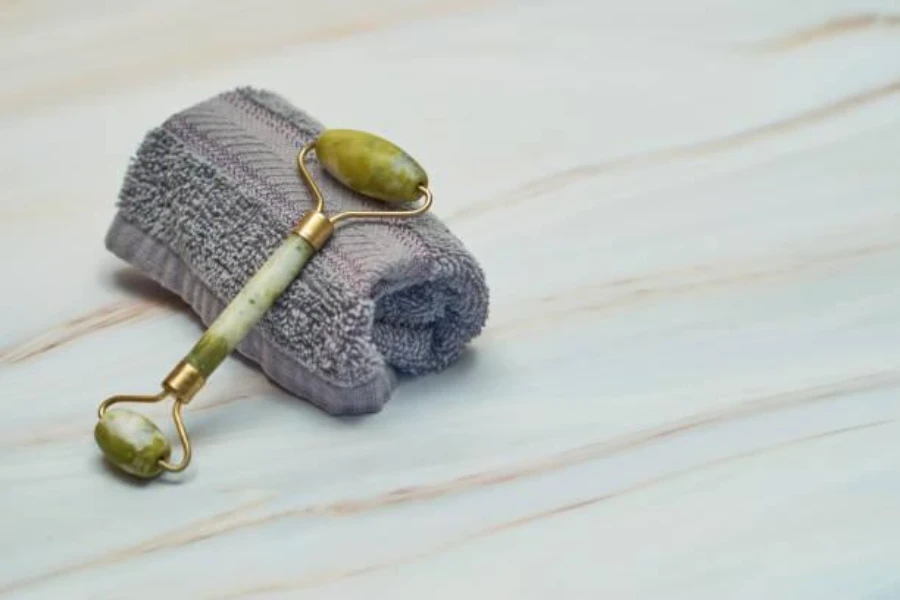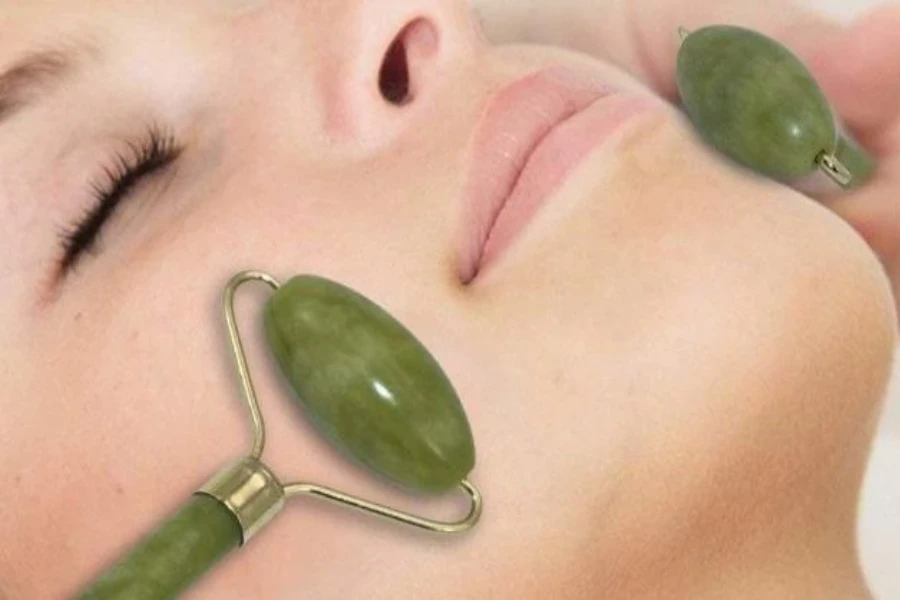The beauty gurus have spoken, and the verdict is in—jade rollers are the secret to instantly radiant skin. And this announcement hasn’t gone unheard among consumers, with these devices recording a 10% rise in monthly searches. Google Ads shows 33,100 searches for jade rollers in November 2023, up from 27,100 in March of the same year.
And they’re not just popular for reducing puffiness and acne. Jade rollers are praised as a must-have tool for realizing internal peace and tranquility. Given their rise in popularity, there’s a great opportunity for businesses to stock these beauty toolkit essentials. So keep reading to discover how to spot the best jade rollers on the market in 2024.
Table of Contents
What are jade rollers?
Market predictions for jade rollers
How to select the best jade rollers in 2024
The bottom line
What are jade rollers?

Jade rollers are believed to date back centuries in skin care. They are facial massage tools made from polished precious stones like jade, amethyst, obsidian and rose quartz. Think of them as tiny rolling pins that can be used on one’s face.
The allure of jade rollers isn’t only in their delicate aesthetics. Here’s what else they have to offer:
- Jade rollers can aid in lymphatic drainage
- They can help reduce puffiness on the face
- They can help smooth out wrinkles
- And they’re perfect for relaxation and stress management.
Market predictions for jade rollers

Demand for jade rollers has soared in recent years as consumers are becoming more interested in self-care and beauty/wellness routines. For this reason, the global jade rollers market is expected to experience a compound annual growth rate (CAGR) of 8.6% from 2022 to 2030, reaching a substantial market value of US$ 820.6 million by the end of this forecast period.
North America dominates the market, with statistics indicating the potential for further advancements in this region.
How to select the best jade rollers in 2024
Jade authenticity
Before businesses purchase jade rollers, they should check the authenticity of the jade. Since the jade rollers market is booming, a sea of fake products has flooded the industry to profit off its potential.
How can businesses spot fake jade rollers? They can tell by simply checking the temperature, fragility, and color of the roller when they ask for a sample. Also, ordering from a trusted manufacturer would help reduce the chances of getting fake jade rollers.
A good jade roller is a little costly, feels cool to touch, and can break if dropped—they also have intricate natural patterns decorating the marble. The rule is if it isn’t jadeite or nephrite, then it’s most likely fake.
Retailers must pay close attention to the jade rollers they purchase because fake rollers can cause harm to the user’s skin and damage the reputation of one’s store.
Craftsmanship quality
Determining the craftsmanship quality of jade rollers is important before adding them to inventories. A roller’s craftsmanship quality determines its durability and ability to function as a skincare device.
A well-crafted jade roller should not be easy to chip. Neither should it easily shift from its frame during use. Jade rollers must be accurately cut to size, roll over the skin smoothly, and feel balanced in the hands.
A little test can be conducted to determine craftsmanship quality after requesting samples. It involves softly tapping the jade roller against the back of a hand. If it cracks or breaks from the impact, then the craftsmanship is poor.
Remember that jade rollers are fragile, so conduct the craftsmanship test gently. Heavy impacts are enough to break even the good quality ones.
Color and transparency

Consumers value jade rollers for their skincare benefits as well as for their ability to offer internal healing. This means that they often link the color of a jade roller to a unique healing property.
Dark green jade symbolizes balance, with many believing it to have calming qualities. While most users believe black jade absorbs negative energy to strengthen protection.
Beyond these internal connotations, jade colors also help determine authenticity. Although jade rollers come in various colors, the shades offered should be of the stone’s natural hue. So, if a jade roller has a chipped coating, it’s likely dyed or fake.
On the other hand, transparency is a purely aesthetic feature that relies solely on consumer preference. Some consumers prefer translucent jade rollers, while others prefer a more evenly toned color.
Size and shape
Since jade rollers are handheld devices, manufacturers make them in different shapes and sizes to suit various user facial contours. If the jade roller is too big, consumers will find it awkward to use. And if it’s too small, the jade roller will not provide any skincare benefits.
Conducting market research on the target consumers will help businesses determine the type of rollers that will make the most sales. Alternatively, they can stock up on various sizes to give consumers a range of choices.
Metal frame quality
Jade rollers perform better when the metal frame is high quality. The frame is what holds all the pieces of the jade roller together. As a result, if the metal frame can’t withstand movement, that’s a problem.
Stainless steel is a popular choice for metal frames due to its strength and rust-resistant properties. Zinc, on the other hand, is a great alternative as they tend to be lighter than their stainless steel counterparts.
The bottom line
Jade rollers are a DIY skincare tool that is rapidly building interest in the mainstream beauty market—and consumers are loving them for their pleasing benefits, with many users holding jade rollers in high regard because of their ability to produce immediate results.
However, the market is also witnessing an increase in fake and low quality rollers that don’t offer the same results as the real ones. That’s why this article advises businesses to consider jade authenticity, craftsmanship quality, shape and size, metal frame quality, color, and transparency before making a purchase. This will ensure that one is well stocked to supply high quality rollers in 2024.




